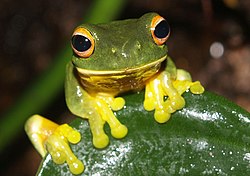| Pelodryadinae Temporal range: | |
|---|---|
 | |
| Orange-thighed frog (Ranoidea xanthomera) | |
| Scientific classification | |
| Kingdom: | Animalia |
| Phylum: | Chordata |
| Class: | Amphibia |
| Order: | Anura |
| Family: | Hylidae |
| Subfamily: | Pelodryadinae Günther, 1858 |
| Type genus | |
| Pelodryas Günther, 1858 | |
| Synonyms | |
| |
Pelodryadinae, also known as Australian treefrogs (although not all members are arboreal), is a subfamily of frogs found in the region of Australia and New Guinea, and have also been introduced to New Caledonia, Guam, New Zealand, and Vanuatu. [2]
Contents
The subfamily is thought to be the sister group to the leaf frogs (Phyllomedusinae), a subfamily of arboreal frogs known from the Neotropics. The common ancestor of both subfamilies is thought to have lived in early Cenozoic South America, with the two subfamilies diverging from one another during the Eocene. The ancestors of the subfamily Pelodryadinae likely invaded Australasia via the Antarctic land bridge, which at the time was not yet frozen over, thus was hospitable for the dispersing frogs. [3] The clade comprising both subfamilies is sister to the Hylinae, from which they diverged in the early Paleogene. [4]
The oldest known fossil of a frog of the Pelodryadinae is of † Litoria tylerantiqua from 55 million years ago. This places a minimum age on the divergence of this group from the Phyllomedusinae, and confirms that these two groups must have likely diverged even earlier. [1]
